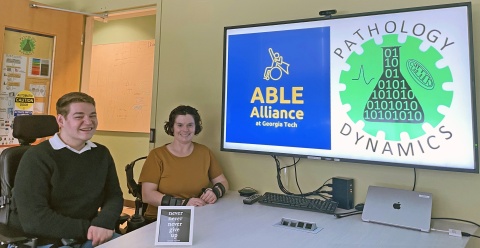Cassie Mitchell and Robert “Trey” Quinn have some questions they’d like to ask you, and there are no wrong answers.
They’re starting a new study that focuses on barriers to jobs in STEM (science, technology, engineering, and mathematics) fields that they hypothesize are well-suited for people with physical disabilities. Technology has made jobs more accessible. And they pay well. But for working people with disabilities, even the higher salaries pose insurmountable challenges.
“We envision a scenario where people with disabilities can enter the workforce and meet their own needs,” said Mitchell, an associate professor in the Wallace H. Coulter School of Biomedical Engineering.
Quinn, one of Mitchell’s former students, graduated in May with a master’s degree in computer science. He was known on campus for wearing a sign on the back of his wheelchair that read “THWG” (“To Hell With Georgia”), an allusion to a shared rivalry between Georgia Tech and the University of Georgia with Quinn’s sister, who attended the latter.
“The overall goal of this data-driven study is to identify factors in academia and industry that have historically hindered the successful inclusion of people with disabilities in STEM careers,” said Quinn, who led the study, which collected data from both disabled and able-bodied participants.
“We want to get a more complete understanding of the current situation, the educational environment and the workplace,” said Mitchell, principal investigator at the Institute of Pathological Dynamics.
Increasing sample size
The research is part of a Science Leadership Award the Mitchell Lab received in October 2022. Supported by the Chan Zuckerberg Initiative and the National Academies of Sciences, Engineering, and Medicine, the program supports early-career biomedical researchers with a track record of advancing diversity, equity, and inclusion. The award includes a five-year, $1.15 million grant.
Mitchell, an internationally recognised Paralympic athlete who was diagnosed with a neurological disorder that left her quadriplegic as a teenager, has always sought to include students from diverse backgrounds and disabilities in her lab.
“There is very little data on inclusion of people with disabilities in the workforce, and only small sample sizes,” Mitchell says, “so we wanted to pursue a larger sample size because if adequate inclusion is not being achieved, and the few existing studies show that it is not, we want to know why.”
“Stable, well-paying careers in STEM fields appear to be realistic options for people with disabilities to achieve and maintain economic independence,” Quinn added.
Fighting the Disability Tax
For people with severe disabilities, even a high-paying job may not be enough to offset the “disability tax,” which Quinn defines as “the extra time and money that living with a disability costs.”
For example, some people need monthly disability payments to cover general living expenses. But often the more valuable government benefit is a health insurance plan that covers “thousands of dollars a month in personal assistance and care services,” Quinn explains. “You often only qualify for this if you’re on government disability benefits and earn less than a certain amount each month.”
And because policies vary from state to state, the complexities of the various programs can easily leave individuals behind, and private or employer-funded health care plans typically can’t compete with government plans that cover these costly personal support services.
For many people with disabilities, it comes down to a choice between working and receiving government-sponsored services.
“There doesn’t seem to be a middle ground,” said Mitchell, who estimates that about 60 percent of her income goes toward medical expenses and disability payments, “and that’s after insurance.”
The researchers hope that this work will help move us closer to full accessibility.
“This research will highlight challenges, even if it doesn’t solve them,” Mitchell said. “We’re focused on STEM, but this kind of research has applications in other fields. I think people understand that we’re asking important societal questions, whether they’re in science or not.”
Conduct research

